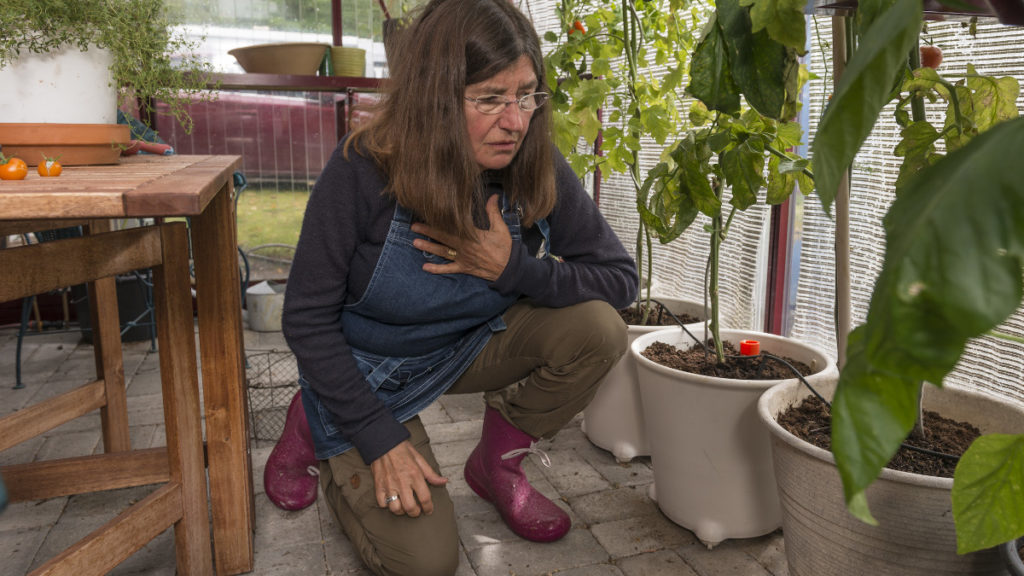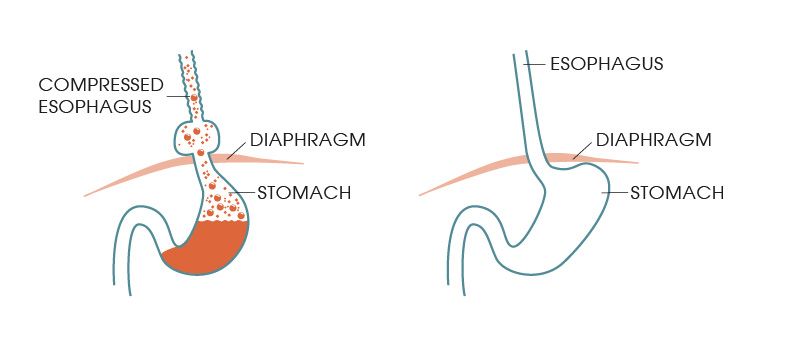Pain in the chest behind the ribs and in the back
Sometimes pain is felt in the chest, in the back, the diaphragm and behind the ribs during or after meals and can then feel like cramp. If you have one or more of these symptoms, it may be a sign of a hiatal hernia.

If the pain is something new that has arisen, increases in strength and you are worried, you should seek medical advice as soon as possible. This may be angina or a heart attack.
Having pain behind the sternum or ribs, in the diaphragm and back can, however, have many explanations that are not acute or dangerous. Other causes of pain in the chest can be inflammation, muscle aches or panic/anxiety disorders.
Why do you get pain in the chest during or after meals?
Simple 3 minute self-test
— immediate results.

Causes of pain in the chest
A hiatal hernia means that your diaphragm is weakened and allows part of the stomach to move into the chest cavity.
The stomach then pushes away other organs and releases stomach acid that together causes pain, which can be confused with a heart attack.
Treating chest pain
If you have pain behind your sternum due to a hiatus hernia, plus symptoms such as heartburn, acid reflux or gastritis, you are often treated with medicines such as: Omeprazol, Omecat, Omezolmyl, Omestad, Losec, Esomeprazol, Nexium, Lanzoprazol, Lanzo, Pantoprazol or Pantoloc which suppresses the production of gastric acid.
However, these are not long-term treatment methods due to the potential adverse reactions[1-7]. The treatment might also be that you change your diet and living habits – surgery is only suggested in more severe cases.
The IQoro is an all-natural neuromuscular treatment and training method, which treats the cause of a hiatus hernia and not just the symptoms, without side effects. It is based on more than 20 years of evidence-based research.
All it takes is for you to train with the IQoro for 90 seconds a day until you feel that you are trouble-free, and then continue with maintenance training.
Read more about treatment with IQoro.
Reference sources
- Läkemedelsvärlden (2011), PPIs are linked to serious side effects, https://www.lakemedelsvarlden.se/ppi-kopplas-till-allvarliga-biverkningar/ Retrieved 26/10/2018 at 14:24
- Region Halland, Läkemedelskommittén (2018), Information om omeprazol och andra protonpumpshämmare, Att sluta med behandlingen, https://www.regionhalland.se/PageFiles/136945/724_Broschyr_A5_PPI_V6.pdf Retrieved: 26/10/2018 at 17:16
- Region skåne, Terapigrupp Gastroenterologi [Gastroenterology Therapy Group] (2017) Att sluta med protonpumpshämmare, Information till dig som skall avsluta din behandling https://vardgivare.skane.se/siteassets/2.-patientadministration/patientinformation/patientinformation-protonpumpshammare.pdf Retrieved 26/10/2018 at 17:19 (removed) New link: https://vardgivare.skane.se/patientadministration/patientinformation/broschyr/att-sluta-med-protonpumpshammare/
- Läkartidningen (2008), Ökad risk för magsjuka med protonpumpshämmare, nr 17 http://ww2.lakartidningen.se/07engine.php?articleId=9323 (borttagen) New link: https://lakartidningen.se/klinik-och-vetenskap-1/lakemedelsfragan/2008/04/okad-risk-for-magsjuka-brmed-protonpumpshammare/
- Läkartidningen (2008), Ökad risk för magsjuka med protonpumpshämmare, nr 17 [Increased risk of stomach issues with PPIs, No. 17], Information om omeprazol och andra protonpumpshämmare – att sluta med behandlingen, Retrieved 30/10/2018 at 13:25.
- Region Örebro County, Läkemedelskommittén [Pharmaceutical Committee] (2017), Patient information – information on Omeprazole and other PPIs, stopping treatment, Retrieved 30/10/2018
- Neal K., Scott H., Slack R., Logan R. (1996), Omeprazole as a risk factor for campylobacter gastroenteritis:case-control study, BMJ vol.312 https://www.ncbi.nlm.nih.gov/pubmed/8601113 Retrieved 30/10/2018
